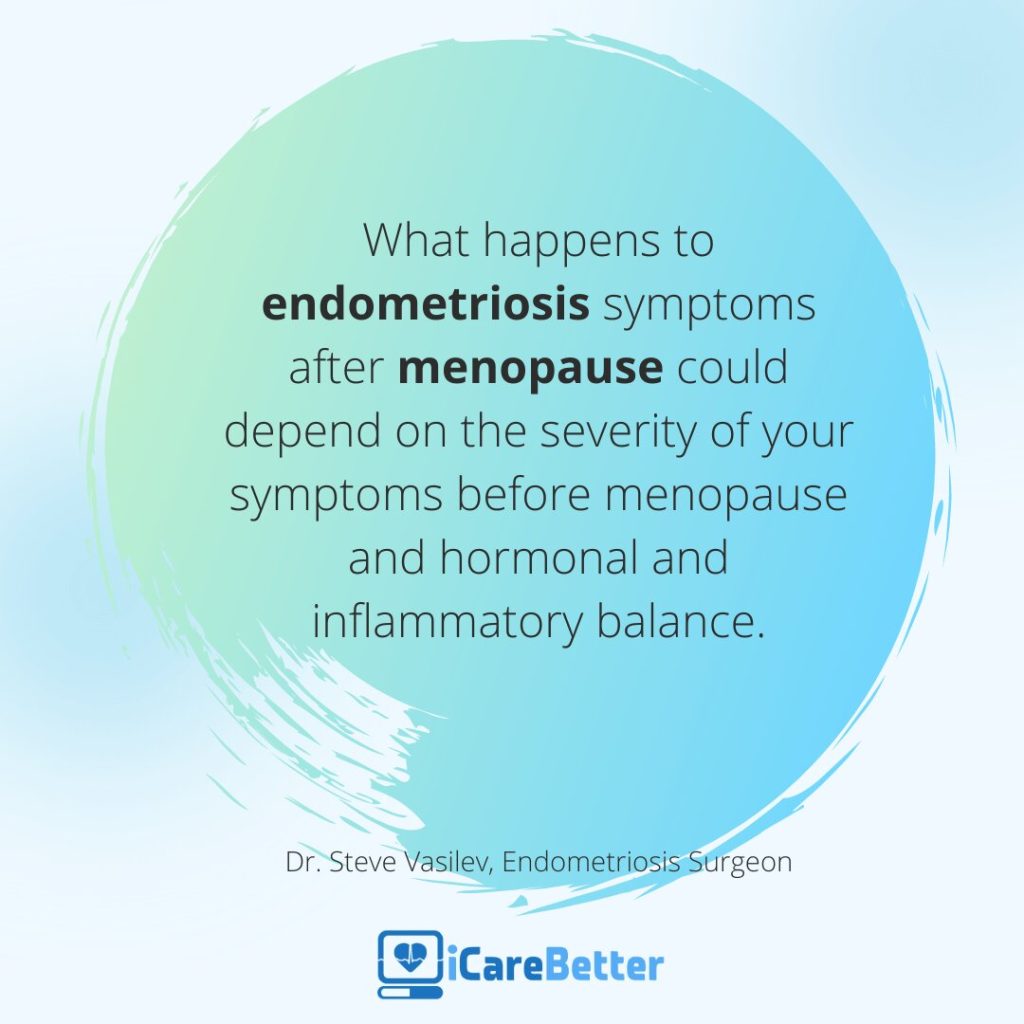
Postmenopausal Malignant Transformation of Endometriosis
Endometriosis is a pain and infertility producing condition which predominantly affects premenopausal women. Estimates suggest that up to 10% of women worldwide suffer from the condition during their reproductive years. While the incidence of postmenopausal endometriosis is considerably lower, studies have suggested that this may still be in the neighborhood of 2.5%. So it is a misconception that endo is exclusively a disease of younger women.
Further, although endometriosis is a benign disorder, there lies a risk of malignant transformation, at all ages. This article delves into the potential for malignant transformation of postmenopausal endometriosis.
Understanding Endometriosis and Menopause
Postmenopausal endometriosis refers to the occurrence or continuation of endometriosis symptoms after menopause, which typically occurs around age 50. This is defined as the cessation of menstrual cycles for twelve consecutive months. After this point, the ovaries produce minimal estrogen, a hormone which is generally considered essential for endo growth. So, without this hormone, or lowered levels, most cases of endometriosis naturally diminish. Yet, for some postmenopausal women, endometriosis can persist or even manifest anew.
The cause or causes of endometriosis in younger women are controversial and incompletely defined. Through uncertain but likely multifactorial mechanisms, endometriosis is characterized by the presence and growth of ectopic endometrial-like tissue outside the uterus. While one might assume that a hypoestrogenic state associated with menopause would alleviate endometriosis, this isn’t always the case.
In postmenopausal women, the causes of endometriosis are less clear. Some contributing factors include:
- Residual Disease: Endometriosis that began before menopause may continue after menopause due to residual disease and growth stimulated by factors other than estrogen or high sensitivity to low estrogen levels.
- Exogenous Estrogen: Hormone replacement therapy (HRT) can potentially stimulate the growth of endometrial cells. This may be particularly relevant for postmenopausal women who take estrogen-only HRT, which can reactivate endometrial implants or even initiate new growths.
- Endogenous Estrogen Conversion: Adipose (fat) tissue can produce estrogen by converting it from other hormones. Postmenopausal women with higher amounts of adipose tissue might produce enough estrogen to promote the growth of endo. Fat can also store xeno-estrogens from certain toxins and then slowly release them into circulation. The tissue microenvironment around endometriosis lesions also contributes to local estrogen production.
Malignant Transformation: A Rare but Possible Event
While endometriosis is overwhelmingly benign, studies have indicated that women with endometriosis have an increased risk of developing certain types of ovarian cancers, specifically clear cell and endometrioid carcinomas.
Some factors that might increase the risk include:
- Duration of Endometriosis: Prolonged presence of endometriosis lesions might increase the risk of malignant transformation. In general, cancer risk increases with age and it is well known that chronic inflammation contributes to formation of cancer. Endo is inflammatory in nature. Thus, if endo is still growing after menopause this means more time in an inflammatory state, hypothetically contributing to the risk.
- HRT Use: As mentioned, exogenous estrogen can stimulate endometriosis growth, potentially increasing the risk of malignant changes in existing lesions. This is not proven but may be a contributory factor which is very complicated due to individual variations in receptor activity and levels of estrogen.
- Genetic Factors: Some genetic mutations might predispose women to both deeply invasive endometriosis and ovarian cancer, and there is overlap. Epigenetic factors regulate which genes turn on an off during life and are influenced by environmental factors. There is also a potential cumulative effect in the number of active mutated genes over the years. Some of the key genetic factors include:
- PTEN: PTEN is a tumor suppressor gene. Its mutations have been identified in both endometriosis and endometrioid and clear cell ovarian cancers. Loss of PTEN function can lead to uncontrolled cell growth and might play a role in the malignant transformation of endometriosis.
- ARID1A: ARID1A mutations are frequently seen in endometriosis-associated ovarian cancers. This gene is involved in chromatin remodeling, and its mutation can lead to disruptions in DNA repair and subsequent malignant transformation.
- KRAS and BRAF: Mutations in these genes are known to play roles in the pathogenesis of various cancers. They’ve been identified in benign endometriotic lesions and might contribute to the early stages of malignant transformation.
- Inherited Genetic Mutations: Women with inherited mutations in BRCA1 and BRCA2 genes, known for their association with breast and ovarian cancers, might also have an increased risk of developing endometriosis and its subsequent malignant transformation.
Conclusions
Postmenopausal endometriosis, although less common than its premenopausal counterpart, cannot be overlooked. The absolute risk of malignant transformation, albeit very low, emphasizes the importance of regular monitoring and endo specialist consultations for postmenopausal women with endometriosis or its symptoms. When postmenopausal endometriosis is suspected or diagnosed, especially if it is invasive and there are unusual symptoms or pelvic masses, a consultation with a gynecologic oncologist is also prudent.
References
Bulun SE. Endometriosis. N Engl J Med. 2009;360(3):268-279.
Pearce CL, Templeman C, Rossing MA, et al. Association between endometriosis and risk of histological subtypes of ovarian cancer: a pooled analysis of case-control studies. Lancet Oncol. 2012;13(4):385-394.
Luca Giannella, Chiara Marconi, Jacopo Di Giuseppe, et al. Malignant Transformation of Postmenopausal Endometriosis: A Systematic Review of the Literature. Cancers (Basel) 2021 Aug 10;13(16):4026.
Luca Giannella, Chiara Marconi, Jacopo Di Giuseppe, et al. The association between endometriosis and gynecological cancers and breast cancer: a review of epidemiological data. Gynecol Oncol. 2011;123(1):157-163.
Sato N, Tsunoda H, Nishida M, et al. Loss of heterozygosity on 10q23.3 and mutation of the tumor suppressor gene PTEN in benign endometrial cyst of the ovary: possible sequence progression from benign endometrial cyst to endometrioid carcinoma and clear cell carcinoma of the ovary. Cancer Res. 2000;60(24):7052-7056.
Wiegand KC, Shah SP, Al-Agha OM, et al. ARID1A mutations in endometriosis-associated ovarian carcinomas. N Engl J Med. 2010;363(16):1532-1543.
Dinulescu DM, Ince TA, Quade BJ, Shafer SA, Crowley D, Jacks T. Role of K-ras and Pten in the development of mouse models of endometriosis and endometrioid ovarian cancer. Nat Med. 2005;11(1):63-70.
Saha R, Pettersson H, Svedberg P, et al. Endometriosis and the risk of ovarian and endometrial adenocarcinomas: a meta-analysis. BMJ Open. 2020;10(4):e034760.

Navigating HRT for Endometriosis and Menopause in Women
Endometriosis, a chronic condition, is often associated with the fertile years of a woman’s life. But what happens when these women reach menopause? Can the symptoms of endometriosis persist, or even worsen, during this transition? This article aims to shed light on these questions and provide guidance for women with a history of endometriosis approaching menopause.
Understanding HRT and Endometriosis: A Quick Overview
Endometriosis is a medical condition characterized by the growth of endometrial-like tissue (the tissue that lines the uterus) outside the uterus. This condition, affecting approximately at least 10% of women in their reproductive years, can lead to debilitating pain, infertility, and other complications. However, the diagnosis of endometriosis often gets delayed due to the non-specific nature of its symptoms and the lack of reliable diagnostic tools.
The exact cause of endometriosis remains unclear, but estrogen dependence, progesterone resistance, inflammation, environmental factors and genetic predisposition are some of the known contributing factors. The primary treatment and support options for endometriosis include hormonal therapy, pain management, pelvic floor physical therapy and excisional surgery.
Endometriosis and Menopause: The Connection
Menopause, the cessation of menstruation, is a natural phase in a woman’s life. It is commonly believed that endometriosis, an estrogen-dependent condition, resolves after menopause due to the decline in estrogen levels. However, this belief is being challenged as more cases of postmenopausal endometriosis are reported.
The persistence or recurrence of endometriosis after menopause can be attributed to multiple factors. One factor may be persistent higher levels of estrogen in some women. One common estrogen source is Hormone Replacement Therapy (HRT) to manage menopausal symptoms. HRT, which usually includes estrogen, may reactivate endometriosis in some cases. However, it is a complex interplay of estrogen, progesterone or progestins if they are included, receptor sensitivity and number and other molecular signaling factors, including the presence or absence of genomic alterations. It’s also important to keep in mind that endometriosis cells and their surrounding support cells can locally produce estrogen. Estrogen can also be generated by the interconversion of other hormones in your fat cells. So, taking hormonal replacement is not the only potential source of estrogen after menopause.
Numerous case reports and series have documented the recurrence of endometriosis or malignant transformation of endometriotic foci in postmenopausal women. In these reports, the majority of women had undergone surgical menopause (ovaries were removed) due to severe premenopausal endometriosis.
Recurrence of Endometriosis
In several case studies, postmenopausal women reported symptoms similar to those experienced during their premenopausal years. These symptoms included abnormal bleeding if the uterus was still intact and pain, often in the genitourinary system. Notably, all women who experienced recurrence were on some form of Hormone Replacement Therapy (HRT), particularly unopposed estrogen therapy.
Malignant Transformation of Endometriotic Foci
Case studies have also reported instances of malignant transformation of endometriotic foci in postmenopausal women on HRT. These cases highlight the potential risk of exogenous estrogen in stimulating malignant transformation in women with a history of endometriosis. It’s critical to point out that this is rare and that is why these are case reports rather than large studies. When these steps towards malignant transformation have been found they are usually associated with genetic alterations like PTEN, TP53 and ARID1A. These alterations are more often found in deep infiltrating and endometrioma types of endometriosis, which are less common than the superficial variant.
Should HRT be Given to Women with Previous Endometriosis?
The decision to prescribe HRT to women with a history of endometriosis is complex and should be individualized on a holistic basis, looking at the risk and benefit overall. This includes risk and benefit for other symptoms and conditions like hot flashes, osteoporosis, heart disease, skin and vaginal changes, and more. While HRT is the most effective treatment for these menopausal symptoms, it may increase the risk of recurrence or, more rarely, malignant transformation of the endometriosis.
Several observational studies and clinical trials have sought to assess the risks of HRT in women with a history of endometriosis. Although these studies suggested a small association between HRT and endometriosis recurrence, the differences between treatment and control groups were not statistically significant. This means that for the vast majority, it is likely safe to take hormone replacement therapy, especially when considering the far more common benefits of such therapy.
Whether or not the uterus has been removed or not is another factor. HRT for those with an intact uterus usually includes estrogen and a progestational agent, most often a synthetic progestin. This is to protect against developing uterine endometrial cancer. If the uterus is surgically absent, then only estrogen is usually administered. There is a big reason for this. The large Women’s Health Initiative (WHI) study performed over twenty years ago revealed that the risk of breast cancer mainly increases with hormone therapy that contains a progestin (synthetic progestational agent). Estrogen alone does not increase this risk. This is because progestins act as growth factors (mitogens) in breast tissue. While natural progesterone was not evaluated in the WHI study, we know that it is not a mitogen from other studies. So, if your uterus has not been removed, from a breast risk perspective, it may be reasonable to inquire about natural progesterone rather than a synthetic progestin as part of hormonal replacement therapy.
It is also important to recognize that ectopic endometriosis cells are not as sensitive to progestational hormones as is eutopic endometrium, located in the uterine lining. So, the real benefit of adding progestin or progesterone may not be as significant as it is in theory. This requires more study, looking at the very complex molecular interplay of these hormones with their receptors located on and in endometriosis cells.
Should HRT be Given Immediately Following Surgical Menopause?
Another question that arises is whether HRT should be initiated immediately after surgical menopause. Delaying the start of HRT could potentially allow any residual endometriotic tissue to regress before introducing exogenous estrogen. However, current research is inconclusive, with studies showing mixed results.
What Menopausal Treatments are Most Appropriate for Women with Previous Endometriosis?
If a woman with a history of endometriosis decides to opt for HRT, choosing the most suitable preparation is crucial. Current research suggests that combined HRT, which includes both estrogen and progestin (or progesterone), may be a safer option for women with residual endometriosis. Keep in mind the caveat about breast tissue and synthetic vs natural progesterone. However, more research is needed to confirm these findings.
Conclusions and Guidance
Navigating the transition to menopause can be challenging for women with a history of endometriosis. While HRT can be effective in managing menopausal symptoms, it may also increase the risk of endometriosis recurrence or malignant transformation.
Women with a history of endometriosis should have a thorough discussion with their healthcare providers about the overall potential risks and benefits of HRT. It is also important to explore the risk and benefit of synthetic vs natural progestational agents. Not all practitioners are well versed in this innuendo.
It’s also important to remember that each woman’s experience with endometriosis and menopause is unique. Therefore, individualized care that takes into account the symptoms, medical history, and personal preferences is crucial.
Ultimately, more high-quality research is needed to better understand the molecular relationship between endometriosis and menopause, and to guide the management of menopausal symptoms in women with a history of endometriosis.
Reference:
https://www.ncbi.nlm.nih.gov/pmc/articles/PMC5850813/

Endometriosis After Menopause: Everything You Need To Know
If you’ve been told that endometriosis goes away after menopause, this may not be the case. So, this may not be a great strategy if you’re trying to “wait out” endo through perimenopause and into menopause.
It is reasonable to think that chronic conditions of your female reproductive organs, like endo, might also go away when you stop having periods. Here’s a look at how endo may or may not change after menopause, based on what we know about molecular biology and hormonal changes as you get older.
This article will cover:
1- Does menopause cure endometriosis?
2- Endometriosis management after menopause
3- Endometriosis after menopause: The molecular biology
4- Endometriosis Symptoms after menopause
5- Endometriosis-molecular level
6- Estrogen replacement after menopause with endo: is it safe?
7- How about compounded natural or bioidentical hormones?
8- How about plant-based phytoestrogens?
9- When is surgery an option for peri and post-menopause endometriosis?
Does menopause cure endometriosis?
Natural menopause does not occur overnight and it might take years before estrogen levels from the ovaries become negligible. Active growth of endo may decrease at this point but, given other estrogen sources discussed in this article and internal molecular factors, it may not stop. So, trying to wait out endometriosis until menopause is final may give it another 5 years or more to grow and cause problems. An active treatment strategy to address endo that persists into peri-menopausal years might limit the damage and lead to better results.
Endometriosis management after menopause
After menopause, the management of endometriosis may become more difficult because by this point in life endo may have been present for decades, even if previously removed partially once or twice by surgery. At this point symptoms may be due to endo as well as scarring and fibrosis, which is part of the body’s normal healing process. The associated problem is that fibrosis and scar does not respond to any medical therapy. This, in turn, means that surgery is the main, if not the only, option for treatment after menopause in many cases. Of course, everyone is different and pelvic floor therapy and supportive care are also in the mix.
Endometriosis After Menopause: The Molecular Biology
Endometriosis cells and tissue look very similar to the normal uterine endometrial lining. Both are stimulated to grow and both try to shed monthly under cycling hormonal influence. During a menstrual period, endometrial tissue has the ability to shed and exit via the cervix and vagina. Unfortunately, the similar-looking endometriosis tissue has no way to exit the body and gets trapped, causing inflammation, scarring, and pain.
Uterine endometrial tissue needs the hormone estrogen to grow, and usually, but not always, so does endometriosis. When you go through menopause naturally, your ovaries produce less estrogen. This causes symptoms such as hot flashes and night sweats. But the commonly held belief is that endometriosis may improve, or even go away, with the reduction in estrogen production by ovaries. We now understand why this does not happen in all women through molecular biology research.
Endometriosis at a Molecular Level
While many factors control endo growth, including immunologic ones, exploring the molecular biology of hormones in menopause suggests that hormones can undoubtedly be a big part of the picture. In addition to the usual conversation about external estrogen from ovaries, which decreases towards menopause, intra-cellular production of estrogens also plays a critical role in the pathogenesis of endometriosis. This increases in peri and postmenopausal women who have persistent active endometriosis lesions.
Without getting lost in the details of hormone enzyme activation and deactivation, which results from genetic switches getting turned on and off, suffice to say that research supports the following. There is local estrogen production in endometriosis cells, which activates other feedback loops at the cellular level. This activation of loops causes even more estrogen production and resistance to progesterone (the balancing hormone). This affects macrophages and pro-inflammatory cytokines (e.g., TNF-α and IL-1β), which sets off another chain reaction. These also create molecular signals (e.g., VEGF) that stimulate microscopic blood vessel formation to feed the endo cells and activate anti-apoptotic genes (e.g., Bcl-2), creating more endo growth. This leads to local tissue trauma, nerve stimulation, fibrosis, and pain.
Endometriosis Symptoms After Menopause

What happens to your symptoms could depend on the severity of your symptoms before menopause and hormonal and inflammatory balance. If your endometriosis is mild, it may get better with menopause. If your disease is severe, symptoms are more apt to persist. Why? Several reasons: scarring and fibrosis that only gets worse and a molecularly more active endo type that persists and keeps growing after menopause. It is currently impossible to predict what type you may have and what molecular signals are in play in any given individual.
If your symptoms don’t improve even after you’ve stopped having menstrual cycles, surgery may be the best option for you. Surgery to remove all of your endometriosis and fibrosis will often be more effective than medication. Years of growth and fibrosis can lead to more local nerve noxious stimulation, and the first step is to remove this. Medications, including natural enzyme supplements, will not dissolve scars, and any persistent active endo is also more difficult to control after menopause. Many other molecular signaling paths are operational, making it harder to determine the best target to block abnormal effects. All the various inter and intracellular signaling forms are under intense research.
Estrogen Replacement After Menopause with Endo: Is It Safe?
All of the above concerns how, when, and where estrogen is produced. But how this affects cells in your body, including endometriosis cells, depends on the presence or absence of estrogen receptors. You can think of the estrogen molecules as little keys which float through your bloodstream and tissues (or locally produced on or near the endo cells), and the estrogen receptors are like little locks present in and on the cells. The two have to connect, or the key has to fit the lock to produce a molecular signaling event at the cellular level. One of these signaling events is whether or not to stimulate growth.
There are different estrogen receptors called estrogen receptor alpha (ERα) and beta (ERβ). In some estrogen-sensitive tissues, like the breast or uterus, these two types can be variably pro-growth, and in others, they can be inhibitory. In addition, there is a progesterone receptor (PR) that binds progesterone in the same fashion via a lock and key mechanism. Endometriosis cells have overexpression of mainly ERβ and underexpression of PR. This imbalanced expression of receptors leads to progesterone resistance and amplification of the growth signal provided by estrogen. This only scratches the surface of incredible complexity, but hopefully, you get the idea.
In general, to alleviate postmenopausal hot flashes, depending on whether you have a uterus or not after menopause, estrogen alone is often prescribed (no uterus) or combined with progesterone (the uterus is in). This is because progesterone balances the effect of estrogen on the uterus and reduces the risk of endometrial cancer due to estrogen-induced overgrowth of the endometrium.
The exact ratio of alpha (ERα) and beta (ERβ) and the amount of PR present can be variable in endometriosis. It can change over time into menopause or after surgically induced menopause due to early removal of the ovaries. So, theoretically, any hormonal replacement will affect endo cells to some degree and may amplify the degree to which local estrogen is produced, as discussed above. The degree to which this happens and evolves is not predictable from person to person.
Where does that leave us? It comes down to risk vs. benefit discussion because a reasonable amount of estrogen replacement after menopause can help the quality of life and bone health. Studies have not proven whether or not this can activate or amplify endometriosis growth after menopause.
How About Compounded Natural or Bioidentical Hormones?
The long answer to this is very complex and depends highly on the quality of these hormones and whether or not the dosages are correctly mixed and, if one were to use combinations that are applied to the skin, degree of absorption, and much more. The problem with synthetic vs. natural arguments notwithstanding, the effect on the very variable and unpredictable receptor signaling described above remains theoretically unchanged. There is also a higher risk of inadvertently taking a higher dose since many are locally prepared and thus subject to less regulation. Get a highly qualified opinion and possibly several opinions and do a lot of due diligence personal research before going this route.
How About Plant-Based Phytoestrogens?
Plant estrogens, otherwise known as phytoestrogens, uniquely attach to estrogen receptors. They can bind to either type of estrogen receptor but preferentially bind to ERβ. In doing so, they take up space and block the ability of regular estrogen to bind to the receptor. In terms of helping menopausal symptoms, estrogen receptors also exist on blood vessels, and the binding of phytoestrogens helps stabilize the blood vessels, reducing hot flashes. The effect is less than that caused by regular estrogen but is helpful in many women. At the same time, there can be a relative blockade at the endometriosis cell level. Again, given the differences regarding receptors and signaling effects between individuals, this is not 100% predictable but can be a win-win nonetheless.
Along the natural, integrative line of thought, a couple of corollary strategies is how the estrobolome and seaweed figure into this puzzle. First, the estrobolome is part of your gut microbiome that can metabolize the excess estrogen in your body and eliminate it. This includes the excess estrogen produced by ovaries, local estrogen created at the cell level, and the toxin type of estrogens called xenoestrogens. Keeping your microbiome healthy and happy with probiotic supplements or fermented foods is the action time. Second, we know that seaweed can predictably reduce circulating estrogen. This can retard any hormonal influence on the regrowth of endo, especially if the bulk of any disease is removed surgically.
Read more: Postmenopausal Malignant Transformation of Endometriosis
When is Surgery an Option for Peri and Post-Menopause Endometriosis?
If symptomatic endo is suspected as one gets closer to menopause, it merits discussion about expert removal of as much as possible via excision surgery. Ideally, a surgeon should remove all visible lesions in this case. Even if undetectable microscopic implants are left behind, removal of pain-producing scars/fibrosis and the bulk of any active endo limits the number of cells that might grow back over time, whether or not hormonal replacement is taken.
There is one more reason for considering surgical removal. If you have a family history of cancer or have active endo as you enter menopause, given the known molecular abnormality overlap between endo and cancer (e.g., ARID1A), the risk of malignant degeneration may be higher. This is a highly individualized situation, but some can be critical to balancing the surgical risks vs. potential benefits.
Surgical Concerns
So, with all of the above in mind, is there a reason NOT to have surgery to remove endo, especially if you have symptoms as you get close to or enter menopause? Of course! Even minimally invasive surgery is not risk-free, and the risks can increase as you get older. Scarring and fibrosis from advanced endometriosis possibly increased from prior surgeries, leading to complications and damage to organs, including the bowel. For this reason, selecting an über expert surgeon at that point in life is crucial.
An über expert surgeon can handle pretty much any possible finding in the pelvis and abdomen. Moreover, they can address oncology risk concerns if you are at higher risk with a family history. This means that the right surgery for cancer would be performed if cancer were suspected or found during surgery. But short of cancer, this surgeon needs to be able to handle small bowel, rectal, bladder, ureteral involvement, even disease in the upper abdomen and diaphragm. Deep infiltrating endometriosis implants are more common if they have been allowed to grow over the years. This full-spectrum surgeon might be a gynecologic oncologist who has experience in endo excision. But even they may need a cardiothoracic surgeon if endo involves the chest cavity. Cardiothoracic surgery is an entirely separate specialty of surgery. Alternatively, a minimally invasive surgery team including an endo excision trained GYN surgeon, a urologist, a general surgeon, and possibly more would need to be available. It can be a logistic challenge to gather such a team, but this is usually possible in centers that specialize in endometriosis surgery.
Join endometriosis forum and discover endometriosis stories
Read on endometriosis forum: What are the long term side effects of lupron?
Get in touch with Dr. Steve Vasilev
More articles from Dr. Steve Vasilev:
Understanding the Connection between Endometriosis and Cancer
How to tell the difference between endometriosis and ovarian cancer
What would happen to the signs and symptoms of endometriosis after menopause?
The author of this article, Dr. Steven Vasilev MD is a fellowship-trained, triple board-certified integrative gynecologic oncologist specializing in complex pelvic robotic surgery. He focuses on advanced & reoparative endometriosis excision and molecular integrative healing, especially as it applies to women of older reproductive age and in menopause.

